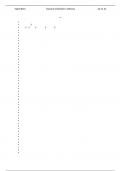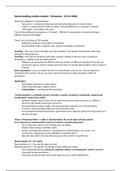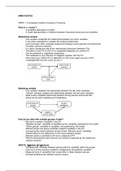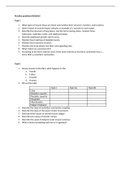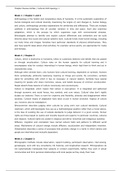Week 1
The electromagnetic spectrum:
the entire distribution of
electromagnetic radiation according
to frequency or wavelength. Although
all electromagnetic waves travel at
the speed of light in a vacuum, they
do so at a wide range of frequencies,
wavelengths. The entire
electromagnetic spectrum →
Examples of fields that use image analysis beyond the visual band:
- astronomy
- satellite
- biological
- medical: MRI, X-Ray, Ultrasound
Fundamental steps in digital image processing:
- Pre-processing: corrects for such defects and
enhances the contrast to improve features of
interest in the image for subsequent analysis.
- Morphological operations: deals with tools
for extracting image components that are
useful in the representation and description
of shape. Is a set of image operations that
process images based on shapes. In a
morphological operation, each pixel in the image is adjusted based on the value of
other pixels in its neighbourhood.
- Image segmentation: is the process of partitioning the image into multiple segments
(sets of pixels or objects), which are more meaningful and easier to analyse.
- Object recognition: the object recognition step assigns a label, such as cell nuclei to
an object based on its descriptors.
- Quantification: to derive quantitative information from features, we can use tools in
Python to measure region properties and other quantities.
Why use python for image analysis?
Python is optimized for array and matrix operations. Image and videos are matrices.
Additionally, python allows you to:
- test algorithms immediately;
- work interactively with your data
- helps you to keep track of files and variables
- simplifies common programming/debugging tasks
,What is an image?
The values in a digital image are all discrete and integers. The
digital image can be considered as a large array of discrete dots,
each of which has a brightness associated with it. These dots are
called picture elements, or pixels.
- The pixels surrounding a given pixel is its neighbourhood.
A neighbourhood can be characterized by its shape. E.g. a
4x4 neighborhood, or a 3x5 neighborhood.
Matrices and images
Images are represented as matrices (e.g. numpy arrays). Instead of representing pixel
positions as (x,y), we use the notation (r,c) indicating the row and column position of a pixel
in the matrix.
Types of images:
- Binary images: each pixel is either black or white. Since there are only two possible
values for each pixel (0/1), we only need one bit per pixel.
- Grayscale images: each pixel is a shade of gray, normally from 0 (black) to 255
(white). This range means that each pixel can be represented by eight bits, or exactly
one byte. Other grayscale ranges are used, but generally they are a power of 2. Pixel
values in gray scale images are never negative.
- Color (multi-channel) images: also RGB images. Each pixel has a particular colour;
that color is described by the amount of red, green and blue in it. Thus one pixel is
described by the amount of red, green and blue. Such images are a stack of three
matrices; representing the red, green and blue values for each pixel. Each channel
goes from 0 to 255, since this is the maximal number 1 byte can represent. If each of
these components has a range of 0 – 225 (non-negative values), this gives a total of
2563 possible colors.
o A color model is a method for specifying colors in some standard way. It
generally consists of a 3D coordinate system and a subspace of that system in
which color is represented by a single point. Objects in images have distinct
colors (hues) and luminosities, so that these features can be used to separate
different areas of the image.
o RGB images: represented as 3 values R, G, and B, indicating the amounts of
red, green and blue which make up the color. Heu and luminosity are
represented in each R, G and B channel.
, RGB to HSV
In HSV images, hue and luminosities are seperated (the
Hue and the Value channels).
- Hue: the true color attribute (red, green, blue,
orange, yellow, and so on).
- Saturation: the amount by which the color has
been diluted with white. The more white in the
color, the lower the saturation.
- Value: the degree of brightness, a well-lit color has
high intensity; a dark color has low intensity.
Image formation
A digital image plane is acquired by recording a digital value proportional to the intensity of
light (or other form of energy) impinging on each pixel of a detector. This intensity usually
corresponds to the amount of light emitted by or reflected from a corresponding point on an
object. Pixel values may be displayed in different ways, determined by a look up table.
Image display
- Operations that change the display without changing the image:
o LUT (colormap)
o Contrast stretching
- Operations that change the image:
o Reversible
o Non-reversible (majority)
Spatial resolution
Spatial resolution is the density of pixels of the image. Greater spatial resolution is more
pixels are used to display images.
→ halve the size of the image: take out every other row and every other column
(interpolation)
→ double the size of the image: all the pixels are repeated to produce an image with the
same size as the original but with half the resolution in each direction (extrapolation)
How do computers handle numbers?
A computer is digital and has finite memory. Stores numbers in uint8 → 8 bit unsigned
integer. It does represent the value range 0 – 255 (28 = 256). Computers and codes almost
always start from zero.
Unsigned versus signed integer
Uint8 and int8 are very similar, but there are some differences.
- Int8 has range -127 to 127
- Uint8 has range 0 to 255 (u = unsigned)
Arithmetic operations
Arithmetic operations act by applying a simple function y = f(x) to each gray value in the
image (e.g., add, subtract, …). Simple function includes:
- Adding or subtract a constant value to each pixel

